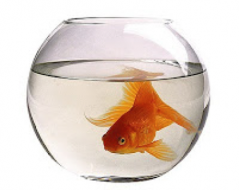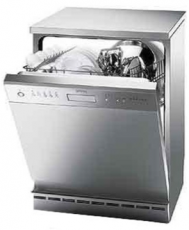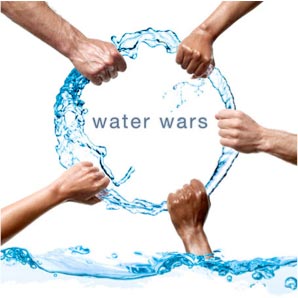Usage
Hi everyone! We’ve reached the halfway point of the urban water cycle and are now at the stage where we investigate water usage. If you think about it, water usage is the whole reason why the urban water cycle exists.
In this module you’ll get an appreciation of how central water is to our day-to-day existence and the functioning of the societies we live in. Water usage can be divided into three main categories:
- Residential
- Agricultural
- Industrial
Think of the types of uses each of these categories represent and discuss within your group if you think these categories cover all uses. Can you think of any others? If yes, post it in the comments at the bottom of this module.
Residential Usage  Drinking, bathing, cooking, watering your lawn, flushing the toilet, filling your pool and your goldfish bowl are some of the common residential uses of water. It’s easy to forget how much we depend on water just to get through the day. The amount we use can vary greatly depending on the weather, where you live, your personal habits (do you shower every day, every other day, or just once a week? Yuck!) and even your yard landscaping. Most of us are not even aware of just how much water we consume.
Drinking, bathing, cooking, watering your lawn, flushing the toilet, filling your pool and your goldfish bowl are some of the common residential uses of water. It’s easy to forget how much we depend on water just to get through the day. The amount we use can vary greatly depending on the weather, where you live, your personal habits (do you shower every day, every other day, or just once a week? Yuck!) and even your yard landscaping. Most of us are not even aware of just how much water we consume.
A measurement of water use that you’ll often hear is “per-capita ” water use (per is Latin for by and capita is Latin for head), or how much water a person uses in a day. The number is usually expressed as gallons of water used per person per day.
 Have a guess at how much water you use per day and share it among your group. You’ve already worked out how much your school uses per capita per day. How does this compare to what you use during a whole day at school and at home? To help calculate this, we have some information to help you work out your total daily water use. To keep things simple and equivalent for all students and schools, let’s assume it’s a sunny hot Wednesday. You get up out of bed and……then what? We want you to work out what your daily household usage of water is, and then by dividing it by the number of people in your household, you have a residential water usage per capita per day.
Have a guess at how much water you use per day and share it among your group. You’ve already worked out how much your school uses per capita per day. How does this compare to what you use during a whole day at school and at home? To help calculate this, we have some information to help you work out your total daily water use. To keep things simple and equivalent for all students and schools, let’s assume it’s a sunny hot Wednesday. You get up out of bed and……then what? We want you to work out what your daily household usage of water is, and then by dividing it by the number of people in your household, you have a residential water usage per capita per day.
Check out this water usage calculator. How do you compare with other students within your school, country and sister school?
There are ways to reduce water usage that are hardly noticeable (or painful!). For instance, you can install water saving fixtures, take shorter and fewer showers (probably not a good idea for some of us!) and/or do larger loads of laundry. Can you think of other ways to reduce water use? This website has 118 ways to reduce residential water usage! Check it out: http://wateruseitwisely.com/100-ways-to-conserve/.
So let’s recalculate your usage if you used water saving fixtures (i.e. low flush toilets), shorter showers and few other water saving devices.
Congratulations, you have just performed a water audit on yourself!
Class Exercise
How much water does a leaking faucet/tap waste? Check your faucets at home -- do any of them drip? Well, maybe it's just a small drip -- how much water can a little drip waste? True, a single drip won't waste much water. But think about each faucet in your home dripping a little bit all day long. What if every faucet in every home on your block ... in your town ... in your state also dripped? The drips would add up to a flood of water wasted down the drain. Do the math using the values below and post your results on the forum!
There is no scientific definition of the volume of a faucet drip, but after measuring a number of kitchen and bathroom sink faucets, for our calculations below (numbers are rounded), we are going to use 1/4 milliliter (ml) as the volume of a faucet drip. So, by these drip estimates:
• One gallon: 15,140 drips
• One liter: 4,000 drips
Looking at it this way, it seems like that drop of water down the drain is pretty insignificant. But, as you can see by the values you just calculated, all those drops flowing in "real time" can really add up to a flood.
But it’s estimated that only 8% of the world’s treated water is used for domestic or personal use. Most of the freshwater usage is for agriculture and industry.
Agricultural Usage
Growing and processing crops and livestock takes a mega amount of water. About 60% of all the worlds freshwater is used for agricultural irrigation! Globally, irrigation (water for agriculture, or growing crops) is probably the most important use of water.

Class Exercise
It takes approximately 2,500 L to produce the food you eat each day. Based on this information work out how many liters of water it would take to feed everyone in the world this amount of food? How does this compare to the amount you drink each day?
Post your results on the forum and provide some visual depiction of what this amount of water would look like (e.g. number of Olympic swimming pools).
All food is not created equal when it comes to the water needed to produce it: some foods are more water ‘expensive’ to produce then others. Check out some of the crazy examples in the below table……hamburgers anybody???
| Food product | Water expense (L) |
| Bread (1 slice) | 40 |
| Chicken (1 kg) | 4,200 |
| Coffee (1 cup) | 130 |
| Corn (1 kg) | 830 |
| Egg | 1,500 |
| Hamburger | 60,000+ |
| Orange | 50 |
| Potato | 380 |
| Wheat | 930+ |
However, water for irrigation is not used equally around the globe, within a country, or even within a state. Different irrigation practices and improved technologies are changing the way we way we water our crops. Have you heard of furrow irrigation? How about trickle irrigation? Do some research and see if you can identify the most AND least efficient irrigation practices that produce the food that is grown near you. What are the pros and cons of each?
Any system that is improperly managed can be wasteful, all methods have the potential for high efficiencies under suitable conditions, appropriate irrigation timing and management. Some issues that are often insufficiently considered are salinization of sub-surface water and contaminant accumulation leading to water quality declines. Discuss within your class what salinization is and how irrigation can lead to salinization and how this can be remedied.
Industrial Usage
Worldwide, industry uses 22% of the available freshwater. The industries that produce metals, wood and paper products, chemicals, gasoline and oils, are major users of water. Probably every manufactured product uses water during some part of the production process. Industrial water use includes water used for such purposes as fabricating, processing, washing, diluting, cooling, or transporting a product; and then for incorporating water into a product (e.g. paint).


Water is used also used to create electricity. Hydroelectric power derives energy from the force of water flowing downhill, driving a turbine connected to a generator. This hydroelectricity is a low-cost, non-polluting, renewable energy source.
Ultimately, the energy in a hydroelectric power plant is supplied by the sun. Heat from the sun evaporates water, which condenses as rain in higher altitudes and flows downhill.

Hydroelectric power plants generally require the creation of a large artificial lake. Evaporation from this lake is higher than evaporation from a river due to the larger surface area exposed to the elements, resulting in much higher water consumption. The process of driving water through the turbine and tunnels or pipes also briefly removes this water from the natural environment, creating water withdrawal. The impact of this withdrawal on wildlife varies greatly depending on the design of the power plant.
Other water uses
What other water uses can you think of? How about Recreation? This includes water bodies used by fishermen, water skiers, swimmers and nature enthusiasts. How about golfing? Those greens require a lot of water to keep green!
Water wars  What happens when there are too many users and not enough water? Water Stress . Water stress is a term used to describe situations in which there is not enough water available for all uses (including personal, agricultural, industrial, etc). The world’s earliest documented water war happened 4,500 years ago, when the armies of Lagash and Umma, city-states near the junction of the Tigris and Euphrates rivers, battled with spears and chariots after Umma’s king drained an irrigation canal leading from the Tigris. It’s even been suggested that the latest conflict in Syria was initiated following a devastating drought beginning in 2006 that forced many farmers to abandon their fields and migrate to urban centers. The high unemployment this created may have possibly have fueled the civil war there. Tensions between nations are also high. Since 1975, Turkey’s dam and hydropower construction has cut water flow to Iraq by 80% and to Syria by 40%. Syria and Iraq have accused Turkey of hoarding water.
What happens when there are too many users and not enough water? Water Stress . Water stress is a term used to describe situations in which there is not enough water available for all uses (including personal, agricultural, industrial, etc). The world’s earliest documented water war happened 4,500 years ago, when the armies of Lagash and Umma, city-states near the junction of the Tigris and Euphrates rivers, battled with spears and chariots after Umma’s king drained an irrigation canal leading from the Tigris. It’s even been suggested that the latest conflict in Syria was initiated following a devastating drought beginning in 2006 that forced many farmers to abandon their fields and migrate to urban centers. The high unemployment this created may have possibly have fueled the civil war there. Tensions between nations are also high. Since 1975, Turkey’s dam and hydropower construction has cut water flow to Iraq by 80% and to Syria by 40%. Syria and Iraq have accused Turkey of hoarding water.
Post Comment
To leave a comment, you must be signed in








